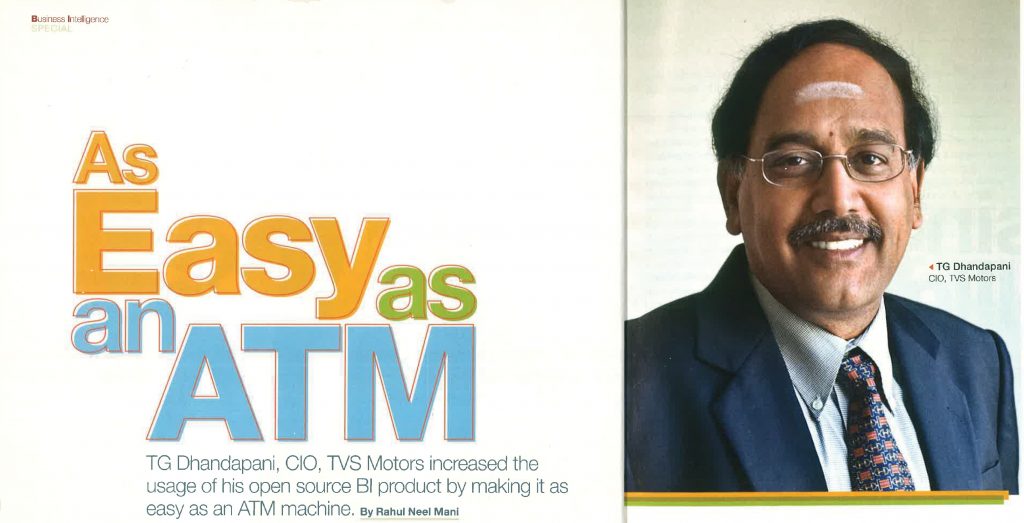TG Dhandapani, CIO, TVS Motors increased the usage of his open source BI product by making it as easy as an ATM machine. By Rahul Neel Mani.

TVS Motor Company is one of the largest industrial entities in India with majority interests in the automobile industry. This includes two wheelers, finance, parts and distribution.
It is also the third largest two-wheeler manufacturing in India and one of the top ten in the world, with an annual turnover of more than $1 billion, and is the flagship company of the $4 billion TVS Group. The company has been growing at close to 35 percent year on year.
With three manufacturing units in India – Hosur, Mysore and Himachal Pradesh – TVS Motors produces 2 and 3 wheelers and markets them through 600 dealerships and 1,200 authorised service centres. Logistics in the company is one of the most important things as the parts are to be procured globally and marketed globally. Continuous improvement in product and service quality is the order of the day. To meet these business challenges, TVS Motors uses information technology as a transformation platform for business innovation and best-in-class operational efficiency. The cultural and organizational transformation at TVS Motor is to change the role of functional managers and employees from being passive information seekers – resulting in better business decisions and performance.
“For this transformation, BI is playing an important role to drive the achievement of strategic and operational objectives of the company” says TG Dhandapani , CIO, TVS Motors.
The first milestone on this journey is to implement ERP and integrate all business processes not only within the company but suppliers and customers as well. “After ERP, the thrust was on knowing more about our customers and performance of our products in the field.”
For this TVS Motors developed the Dealer Management System (DMS). “It is an ERP for the dealers that talks to the company ERP seamlessly and provides valuable information on customer profiles and product performance from the electronic job card used in the DMS,” says Dhandapani.
The next stage was the digitisation of New Product Development for which valuable information were received from the DMS. This was followed by shop-floor were digitized for improvement in productivity and product performance. “At this stage BI was implemented to drive the achievement of strategic initiatives and operational performance improvement. A cross functional team was formed where stakeholders from all functions participated. IT was spearheading the team.”
THE ROLE OF IT
The role of IT here was to provide an appropriate platform while maintaining focus on the strategic objective. BI was implemented by integrating the ERP and DMS. The ERP covered all areas including PLM and CRM. There were other non-mission-critical applications too. “These included time management, Travel, Fleet management, Taxi management, Visitor management, Shop-floor integration projects and so on.” Dhandapani said Those 20 applications were not a part of the ERP and Dhandapani decided to use an open source BI solution, Dundas, to provide intelligence. “This BI tool is user friendly and can be easily used by the shop floor worker also”, he says. In TVS motors all employees get their full personal information including compensation details. Loan, Leave and so on using this open source tool.
Dhandapani says that the main force for the decision to go for the tool was its simplicity, elegance and effectiveness. He also notes that this open source BI tool is very useful and effective for the data pulled from ERP in smaller companies.
IMPLEMENTATION
Generally BI tools are used extensively by employees that are not comfortable with technology. Since these tools are designed to give on-demand information, they are not too different from designing a good mobile phone or a user-operated kiosk. For a tool to be good and efficient it should be so transparent that the user does not even know that they are using a tool. Case in point, take ATM machines. They are so simple to use that practically no training is required.
As Dhandapanu observes, “Any BI implementation is a journey and we could understand that the user involvement and their thirst for analysis is the limitation. Once this is in place simplicity of operation is important. As we ensured that the operations of this BI system were as simple as using an ATM, we could see many IT users joining and contributing for enhancement.”
BENEFITS
TVS Motors has seen significant benefits. The first win for the IT department has been the users are actually using the system to its potential. Otherwise you may create tens of dashboards for the employees to use, but they may not use them simply because wither they are not comfortable or there is resistance to change. By using a smart system and by proper employee orientation TVS Motors has surpassed this milestone with ease.
With this out of the way, the users are actually using the system for tangible business benefits. Dhandapani concludes that “In the short term we could see usage mushrooming and in long term we will experience IT users taking informed decisions. We also expect to see functional managers and employees as proactive information seekers to improve business decisions and performance.
